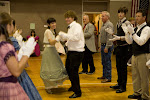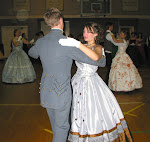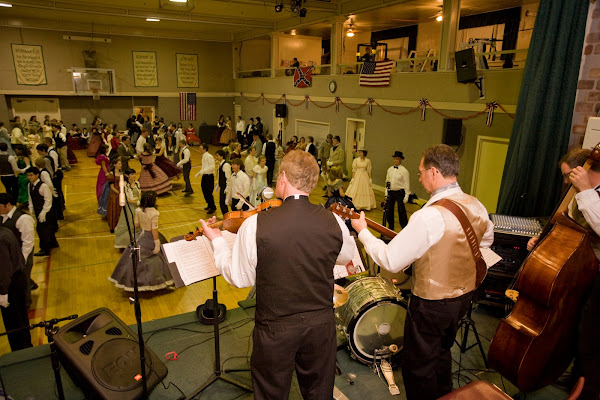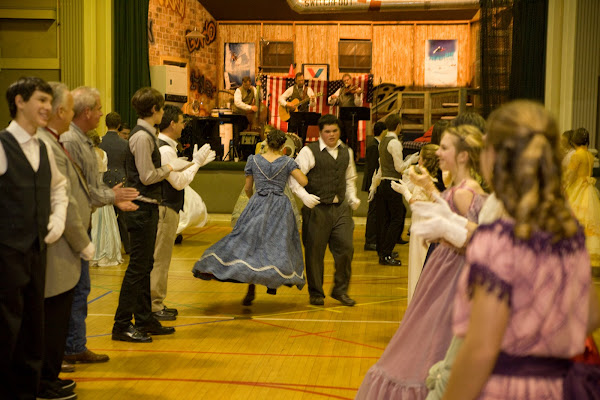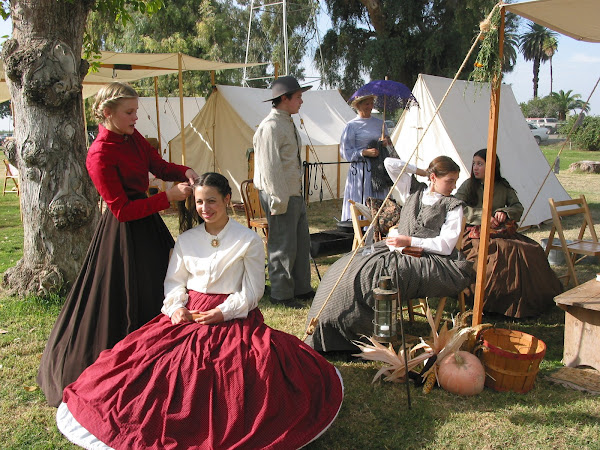“Gentleman, reach across to the lady opposite you with your right hand and take the lady’s left hand in yours. Ladies, go under the gentleman’s arm as you both make a quarter turn.”
These are the instructions for making a quarter turn in our circle waltz dance – Spanish Waltz. The words may be confusing at first, but once you see it done, it is easy. Communicating knowledge to you with my words AND actions gives you a lot more information.
In-person, vocal communication has a physical dimension. I always talk with my hands –sometimes so vigorously that I have elbowed one of my children standing behind me in the face. But even if you don’t wave your arms around and around like I do, there is still movement in your shoulders, head and face that is communicating to your listener, perhaps even more than your voice.
In the 1960’s William Condon, analyzed social micro rhythms by video taping conversation between small groups of people and then slowing the videos down to watch the mirco-moments. He found that each speaker in the video would move a shoulder, cheek, eyebrow or hand in perfect time with their own words so that each person was basically dancing to their own speech. And that is not all. All of the listeners were making similar movements as well, and they were in perfect harmony with those of the speaker. Other studies have shown that it’s just not the movements that get synchronized, but it is the volume and pitch of the voices as well.
I just finished a book this week by Malcolm Gladwell called The Tipping Point. It is a fascinating book about how social epidemics – both good and bad – get started. The author talks about the importance of persuasive communicators and how they get their message across. Glad tells of meeting with a very persuasive salesman, Tom Gau. He says, “We know how people talk back and forth. They listen. They interrupt. They move their hands. In the case of my meeting with Tom Gau…some of the time he leaned forward and planted his elbows in front of him. Other times he sat back in his chair and waved his hands in the air… If you had a videotape (of our meeting) and slowed it down until you were looking at our interaction in slices of a fraction of a second, you would have seen … the two of us engaged in what can only be described as an elaborate and precise dance.”
Have you ever thought about your conversations as being a dance? Are some people better conversationalists (and better dancers) than others? Does dancing help you become a better communicator? A more persuasive speech maker? Like most skills, the more you practice, the better you get. So get out there and dance, and you may find that you receive the extra benefit of becoming a better communicator as well.
Maybe you didn’t realize it, but you and everyone around you are dancing all the time!
The Prince and the Princess
Many of my favorite stories involve a "princess" being rescued by a handsome "prince." It may be an old fairytale like Sleeping Beauty or a modern remake like the movie Enchanted, or perhaps a classical literary piece like Sense and Sensibility. Every little girl dreams of the day when her prince in shining armor will come and take her away to be party of a bigger story as she plays dress-up with silky scarves and lace. Every little boy practices being a fighting warrior by whacking at trees with sticks and throwing rocks at tin cans.
Our Civil War Balls give children, youths and adults a chance to be the Prince or Princess for the evening. Our music pastor attended our last ball, and as the father of three daughters, one of whom was married this summer, he said that the thing that touched his heart about the dances the most was watching the fathers dance with their daughters. These young girls look to their daddy to know if they are pretty and worthwhile. When a father turns and spins his satin-dressed daughter, he says that she is.
When the prince in Sleeping beauty rescues the princess, he must first defeat the fire-breathing dragon. For some young men who attend the balls, asking a young lady to dance is even scarier than fighting a dragon. But the young prince's valor increases as he overcomes and conquers this fear. (Okay, this is a little over dramatic, but I still think that the essence is there.)
At our balls, it is the gentleman's responsibility to ask a girl to dance and invite her to be party of the story. It has been asked by several of the young men (and never the ladies!) if we could have some of the dances be "ladies' choice." But as it would take away from the story of sleeping beauty if the princess jumped out of the tower with a hatchet and took care of the dragon herself while the prince was off drinking lemonade with his pals, in the same way it would decrease the honor and beauty - the essential story line - of the Ball.
Be party of a story with grace and beauty, valor and courage - Attend a Grand Ball!
Our Civil War Balls give children, youths and adults a chance to be the Prince or Princess for the evening. Our music pastor attended our last ball, and as the father of three daughters, one of whom was married this summer, he said that the thing that touched his heart about the dances the most was watching the fathers dance with their daughters. These young girls look to their daddy to know if they are pretty and worthwhile. When a father turns and spins his satin-dressed daughter, he says that she is.
When the prince in Sleeping beauty rescues the princess, he must first defeat the fire-breathing dragon. For some young men who attend the balls, asking a young lady to dance is even scarier than fighting a dragon. But the young prince's valor increases as he overcomes and conquers this fear. (Okay, this is a little over dramatic, but I still think that the essence is there.)
At our balls, it is the gentleman's responsibility to ask a girl to dance and invite her to be party of the story. It has been asked by several of the young men (and never the ladies!) if we could have some of the dances be "ladies' choice." But as it would take away from the story of sleeping beauty if the princess jumped out of the tower with a hatchet and took care of the dragon herself while the prince was off drinking lemonade with his pals, in the same way it would decrease the honor and beauty - the essential story line - of the Ball.
Be party of a story with grace and beauty, valor and courage - Attend a Grand Ball!
The Dancer as the Star in the Epic of Life
"I've always felt life first as as story - and if there is a story, there is a story teller." - G.K. Chesterton.
I've been writing and directing plays since I was in elementary school. My first "big" production was a Christmas play that I wrote when I was around ten years old. I roped my siblings and relatives into performing and asked my pianist mother to play the music that I had carefully picked out. I even typed up programs (with several misspellings - I know because my mother saved them) to hand out to the audience. It never became a hit play on Broadway, but for me, it was life changing.
Fast forward past my marriage and on to the birth of our three children. I realized that I could incorporate my love of children, history AND drama by offering to direct (and sew costumes and paint scenery) for an American Girl Felicity play. My oldest daughter and her friends were about six years old when we put on this grand production. We practiced a lot, and since a few of the girls in the play were not good readers yet, the mothers got together and read our own daughter's part into a tape recorder so they could learn their lines by listening. We were able to use a local church for the performance and had a sizable audience. My greatest delight was to watch the girls shine in the roles that they had worked so hard in preparing. It was worth all the time and effort to watch them become more than they were when they started. I got to, in a small way, be part of their life's story.
I've gone on to direct plays for other children's groups and choirs, and I've directed choreography as well. And each time as I sit in the dim light of the front row watching and cheering the stars of the production on and watching them shine, I am deeply satisfied. And I get the same sense of satisfaction teaching and calling dances at the balls. But at these dances, instead of having a few "stars" and a large audience, everyone gets to have a part and be one of the "stars" at the event. And just like a play, we practice their parts by teaching the dance steps, and then when the music plays, each person is ready to be the prince or princess of their evening's story.
I believe we are all part of a bigger story. John Eldredge says in his book Epic, "Live unfolds like a drama. Doesn't it? Each day has a beginning and an end. There are all sorts of characters, all sorts of settings. A year goes by like a chapter from a novel. Sometimes it seems like a tragedy. Sometimes like a comedy. Most of it feels like a soap opera. Whatever happens, it's a story through and through."
I look forward to dancing with you sometime, and being part of your story!
I've been writing and directing plays since I was in elementary school. My first "big" production was a Christmas play that I wrote when I was around ten years old. I roped my siblings and relatives into performing and asked my pianist mother to play the music that I had carefully picked out. I even typed up programs (with several misspellings - I know because my mother saved them) to hand out to the audience. It never became a hit play on Broadway, but for me, it was life changing.
Fast forward past my marriage and on to the birth of our three children. I realized that I could incorporate my love of children, history AND drama by offering to direct (and sew costumes and paint scenery) for an American Girl Felicity play. My oldest daughter and her friends were about six years old when we put on this grand production. We practiced a lot, and since a few of the girls in the play were not good readers yet, the mothers got together and read our own daughter's part into a tape recorder so they could learn their lines by listening. We were able to use a local church for the performance and had a sizable audience. My greatest delight was to watch the girls shine in the roles that they had worked so hard in preparing. It was worth all the time and effort to watch them become more than they were when they started. I got to, in a small way, be part of their life's story.
I've gone on to direct plays for other children's groups and choirs, and I've directed choreography as well. And each time as I sit in the dim light of the front row watching and cheering the stars of the production on and watching them shine, I am deeply satisfied. And I get the same sense of satisfaction teaching and calling dances at the balls. But at these dances, instead of having a few "stars" and a large audience, everyone gets to have a part and be one of the "stars" at the event. And just like a play, we practice their parts by teaching the dance steps, and then when the music plays, each person is ready to be the prince or princess of their evening's story.
I believe we are all part of a bigger story. John Eldredge says in his book Epic, "Live unfolds like a drama. Doesn't it? Each day has a beginning and an end. There are all sorts of characters, all sorts of settings. A year goes by like a chapter from a novel. Sometimes it seems like a tragedy. Sometimes like a comedy. Most of it feels like a soap opera. Whatever happens, it's a story through and through."
I look forward to dancing with you sometime, and being part of your story!
Welcome to my Dance, Music and History Blog!
I originally created this page to give people information about the teaching and dance calling that I am doing at local dance events, but now we have our own website at http://www.heritagedanceevents.com/. Please check it out if you are interested in attending or hosting a Victorian Era Ball. And if you have any questions or comments about anything that you read here, you can always contact me at www.heritagedanceevents@gmail.com.
I am now going to use this blog to write my muses about dance, music and history. There are many benefits and reasons to dance, and I plan to explore some of the following topics:
The Dancer as the Star in the Epic of Life
The Prince and the Princess
Communication as a Form of Dance
Dancing as a Respite from Isolation
I'll also share with you some random facts and various quotes.
To get us started, here's random fact #1. Did you know that the Greeks used dancing as the chief means of physical training for their soldiers? And that famous Greek Plato said, "To sing well and to dance well is to be well educated."
As a teacher with a passion for dance, music and history, my hope is that my blogs will be entertaining, educational and will give you a reason to get up and dance!
Dancing on,
Debra Newby
All essays on this blog are copyrighted and may not be copied or printed without permission. Debra Newby/2009
I am now going to use this blog to write my muses about dance, music and history. There are many benefits and reasons to dance, and I plan to explore some of the following topics:
The Dancer as the Star in the Epic of Life
The Prince and the Princess
Communication as a Form of Dance
Dancing as a Respite from Isolation
I'll also share with you some random facts and various quotes.
To get us started, here's random fact #1. Did you know that the Greeks used dancing as the chief means of physical training for their soldiers? And that famous Greek Plato said, "To sing well and to dance well is to be well educated."
As a teacher with a passion for dance, music and history, my hope is that my blogs will be entertaining, educational and will give you a reason to get up and dance!
Dancing on,
Debra Newby
All essays on this blog are copyrighted and may not be copied or printed without permission. Debra Newby/2009
Subscribe to:
Comments (Atom)


